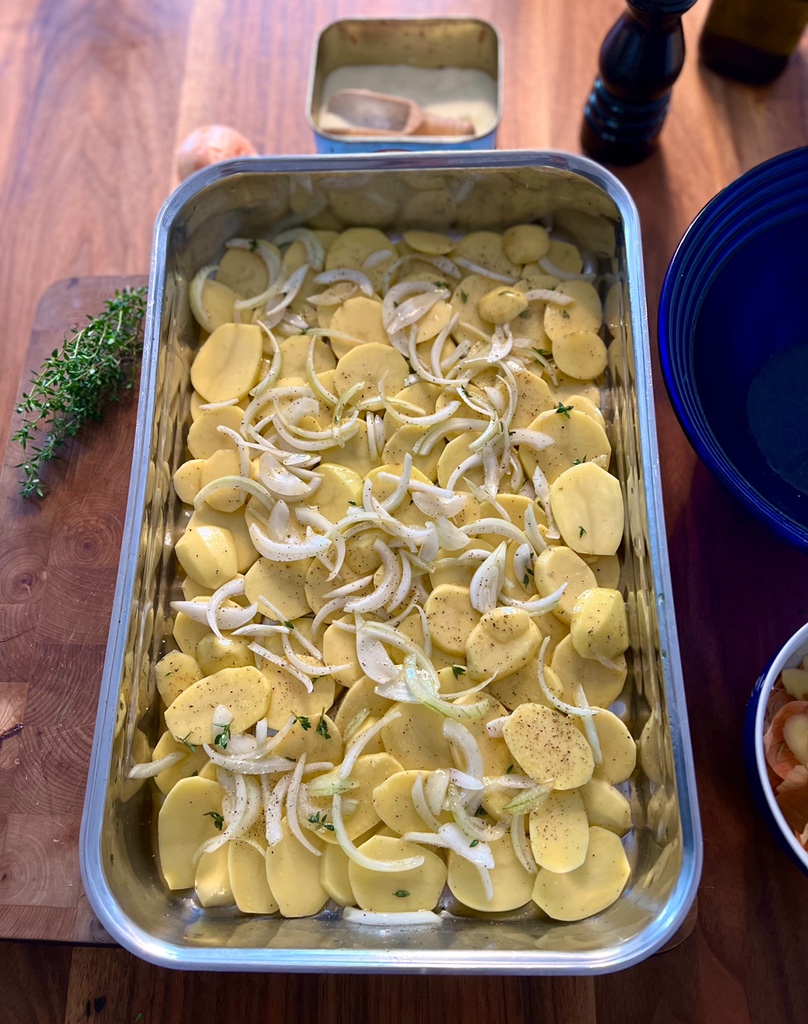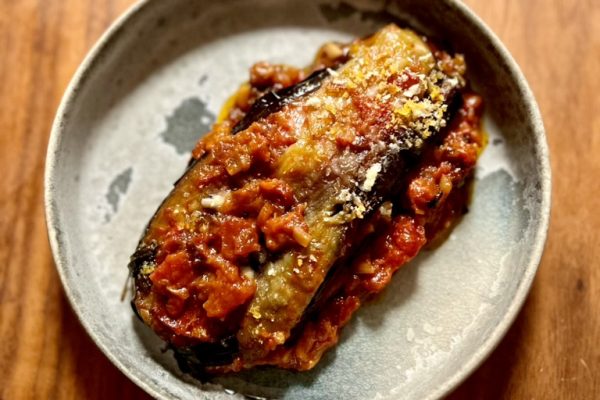Anyone who has eaten Moussaka in a Greek restaurant inside or outside Greece is unlikely to have put this dish on the shortlist of highlights of this cooking culture. Which is an absolute shame, because it’s utterly delicious if you prepare it properly and with love.
There are two reasons for this problem: Firstly, the aubergines in particular, or even all the vegetables, are usually deep-fried – and that’s how the whole dish tastes. Secondly, a moussaka can be easily prepared and reheated at will. This makes it an excellent placeholder on the menu of a restaurant, but not necessarily more palatable if it is served warmed up in the microwave.
The very best moussaka ever – as certified to the Tastemaster by a Greek woman who is serious about food (and everything else too: kisses to Alexandra) – goes back to an ingenious recipe idea by Akis Petretzikis, and you’re encouraged to check out his YouTube channel.
So here is our version of this fantastic, but unfortunately often pitifully poorly prepared classic:
First, preheat your oven to 200 degrees with fan. Without fan, which is always a rule of thumb, add 20 degrees.
Then you start with potatoes and onions.

Put everything into a bowl and season with salt, pepper and thyme leaves. Then add olive oil and mix everything thoroughly with your hands. It is the right amount of oil when the potatoes and onions are just coated with it, more is not necessary.

Layer the potatoes and onions in a baking pan so that the whole base is evenly covered.

Then place the pan in the preheated oven for 20 minutes.
In the meantime, cut the aubergines crosswise into equally thin, round slices.

The aubergine slices are also seasoned with salt, pepper and thyme. They soak up the olive oil very quickly. Don’t let this irritate you and don’t add too much oil – if all the slices have had some, it’s fine.

After 20 minutes, the potatoes and onions look like this:

Place the aubergine slices on top and put everything back in the oven for 20 minutes.

Now cut the courgettes into equally thin slices and season again in the same way. You don’t need much oil, but again it should be well distributed with your hands.

Put on a layer of your seasoned and oiled courgettes:

And again, the whole thing goes into the oven for 20 minutes. After that it looks like this:

In the meantime, or even before, you can take care of the last two layers of this gratin – meat sauce and béchamel.
A vegetarian moussaka would be very easy to prepare. But today we’ll stick to the classic recipe, which tells you everything you need to know in order to be able to vary it individually.
For the meat sauce, chop the onions and garlic; it doesn’t need to be too fine.

Gently sweat the onions and garlic in a little olive oil over medium-high heat; they should not brown. Season with powders of clove, allspice, cinnamon and a little chilli or cayenne.

To this we now add tomato paste and mix everything quickly and thoroughly.

Then we add our minced meat. Lamb, beef and mixtures of these work best.

We recommend seasoning the browned meat with a little Worcester sauce and light soy sauce for more flavour intensity. In addition, we now grind black pepper over it.

Then we add chopped tomatoes, fresh or canned, depending on the season.

Finally, you can season with salt. Gently, because your vegetables were already salted slightly.

Now for the béchamel, which is prepared in a very classic way:
Melt the butter over medium-high heat in a large pot. It should not brown.

Add all the flour to the butter, …

… which is immediately stirred in with a whisk until everything is smoothly mixed.

Don’t leave it on the cooker for long, otherwise the flour would brown and end up as a dark roux, which is not what we want.
Add the cold milk little by little and whisk it into the mixture.
You can add about 200 ml of milk at a time. However, mix everything thoroughly and let it develop for at least a minute before adding more milk, otherwise lumps will form.
Don’t be surprised by the usual course of events. After the first addition of milk, the mixture very quickly becomes very firm, so that it hangs almost completely on your whisk. This doesn’t matter and is only because the flour is swelling, and not enough milk has been added just yet. It will become smoother and more liquid again with each subsequent step.
When all the milk has been incorporated, let it simmer gently for a good 5 minutes. Keep stirring, otherwise it will burn on the bottom. You have now made a classic béchamel.
Then season with ground pepper and grated nutmeg.

When the béchamel is no longer boiling hot, add the egg yolks and grated Parmigiano Reggiano. Because of the Parmigiano, you do not need to add salt. Immediately mix everything together thoroughly.

Now add chopped herbs to your meat sauce, parsley and basil are a very good combination. Also add a good third of your béchamel.
Mix everything thoroughly again and then spread as another layer on the vegetables in your baking pan.

Spread your remaining béchamel on top and grate Parmigiano Reggiano over it again until everything is delicately covered.

Now bake everything at 180 degrees fan (or 200 degrees without fan) for about 40 minutes. After 25 minutes, check the browning of the surface for the first time. If it gets too dark, put some aluminium foil on it.

Now you can portion the moussaka with a knife and arrange it on flat plates with a spatula. It is now not too moist and certainly not dry. With each step of this recipe, more flavour has gone down into the potatoes – try a piece on its own.

We always make a lot of it and eat it two days in a row. It doesn’t get boring.
Enjoy.
And may the taste be with you.
Ingredients (for at least 6 hungry people):
Vegetable layers:
3 – 4 fist-sized potatoes or correspondingly many smaller ones
2 – 3 aubergines, depending on size
2 – 3 courgettes, depending on size
Salt, pepper, fresh thyme
Meat sauce:
2 medium onions
3 – 4 garlic cloves
Two small spoonfuls each of ground cloves, cinnamon, allspice
Chilli or cayenne to taste
One large tablespoon of tomato paste
600 g minced meat (lamb and/or beef)
400 g chopped tomatoes
Black pepper and salt
Optional: Light soy sauce and Worcester sauce
Parsley and basil
Bechamel:
100 g butter
100 g flour (standard, spelt or wheat)
750 ml milk (cold)
Black pepper and grated nutmeg to taste
120 g Parmigiano Reggiano
3 egg yolks
For the finale:
120 – 150 g Parmigiano Reggiano





2 thoughts on “Moussaka”